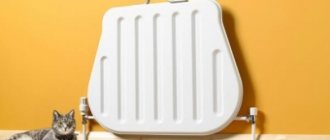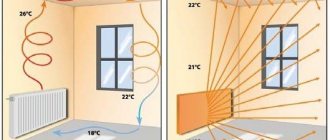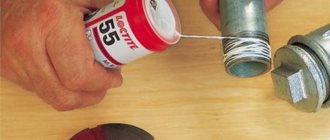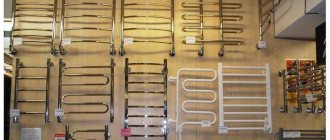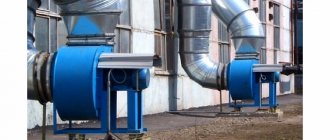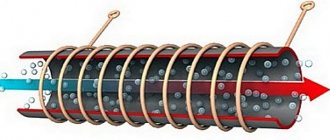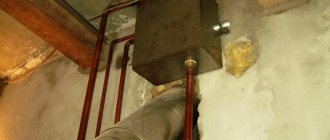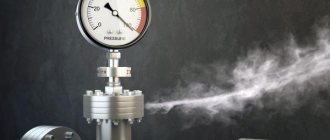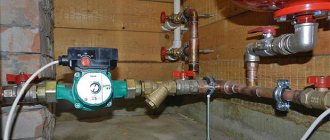The change in pressure during thermal expansion without taking into account the deformation of the system elements can be calculated using the formula: Δp = βt · Δt / βv, where βt is the coefficient of thermal expansion of water, 1/°C; Δt – change in water temperature, °C; βv – coefficient of volumetric compression of water, 1/Pa. Calculations show that in a rigid closed system, the pressure change is about 3 bar/°C. If we take into account pipe deformations, the results will be as follows:
|
How does the VALTEC expansion tank work? The expansion membrane tank contains a diaphragm that divides it into two parts, one of which contains nitrogen, which is under initial excess pressure, and the other part receives excess coolant from the system.
Initially, the entire volume of the expansion tank is completely occupied by nitrogen; When the coolant is heated, its volume increases, which leads to nitrogen compression. The pressure of the nitrogen blanket increases and equalizes the pressure in the heating system at a given static level. When the temperature of the coolant and, accordingly, its volume decreases, the pressure of the nitrogen blanket returns the coolant back into the system, preventing the pressure in the system from falling below the set level.
| Under operating conditions, the inner surface of the membrane expansion tank body is often an area of possible condensation. If there is oxygen in the gas cushion, intense corrosion of the metal of the tank body will inevitably begin. That is why manufacturers pump neutral nitrogen into the tank, and not atmospheric air containing water vapor and oxygen. By pumping air into the gas cavity, the user unwittingly shortens the service life of the membrane tank. |
Connection point of the VALTEC expansion membrane tank to the heating system
The pressure at the point of connection of the membrane tank to the system is always equal to the static pressure at a given point at given temperature parameters.
| Proving the above statement is very simple. If we assume that the pressure at the tank connection point changes, then we will have to admit that the volume of coolant in the tank has also changed. But this cannot be, because... There was nowhere for excess coolant to come from in a closed system, and there was no way it could disappear without a trace either. It should be noted that this rule only applies to a system with one expansion tank. |
Thus, the operating parameters of all other elements of the heating system, the required initial pressure in the expansion tank and the volume of the tank itself depend on the location of the expansion tank.
| When choosing the location for connecting the expansion tank, remember that the higher the pressure in the heating system, the less likely it is to become airborne. |
| If the membrane tank is connected to the system directly after the circulation pump, you should check that an anti-cavitation pressure reserve is maintained in front of the pump. |
In Fig. 1 shows several options for connecting a membrane tank to a heating system with the following height parameters:
- excess of the top point of the system over the bottom (H) – 10 m;
- the heat generator and safety valve are located 2 m above the lowest point of the system (h1);
- the expansion tank is placed 1 m above the point of its connection to the system (h2);
- static pressure at the lowest point of the system is 15 m of water. Art.
Rice. 1. Options for connecting the membrane tank to the heating system
At the remote flags in Fig. 1 indicates the calculated values of operating pressure at characteristic points of each system (in m of water column).
The safety valve setting value is assumed to be 33 m water. Art., pump pressure – 6 m water. Art., system capacity – 200 l. The difference between the maximum and minimum temperatures of the coolant is 80 ºС.
In table 1 shows the calculated characteristics of membrane tanks for circuits with their different connections.
Table 1. Calculated data for systems in Figure 1
| Scheme in Fig. 1 | Estimated preliminary pressure in the tank, m water. Art. | Estimated tank capacity, l | Brand of selected tank VALTEC |
| A | 13 | 14,9 | VRV18 |
| b | 13 | 14,9 | VRV18 |
| c | 11 | 14,2 | VRV18 |
| d | 11 | 14,2 | VRV18 |
| e | 3 | 11,5 | VRV12 |
| f | 3 | 11,5 | VRV12 |
| When installing a membrane tank in a gravity heating system on the upper line, it should be shifted from the main riser towards the heating risers in order to eliminate the parasitic effect on the circulation of the coolant cooling in the tank. The main riser must be equipped with an air vent and a safety valve (Fig. 1f). |
The coolant must enter the membrane tank from above. In this case, there is no chance of air getting into the liquid compartment of the tank. If this requirement cannot be met, it is recommended to follow these rules:
Rice. 2. Options for organizing the release of air from a system with a membrane tank |
Is it necessary to install an additional expansion tank?
Good evening, question about the process of installing a bathhouse, specifically a double-circuit wall-mounted gas boiler 24 kW Wolf. I convince people that an additional expansion tank is needed for the heating system, so 12-14 liters, in addition to the built-in 8 liters, we have 1 supply and return from the boiler to the manifold group for 6 outlets for heated floors, the total square footage of the heated floor is 70 square meters and hot water and HVS tell me I’m right. Eugene
The required volume of the expansion tank is formed by calculation:
VL – total capacity of the heating system (volume of coolant in the boiler, heating devices, pipes, boiler coil and heat accumulator), l;
E – indicator of fluid increase, %;
D – efficiency of the membrane expansion tank.
For its part, D = (PV – PS) / (PV + 1)
РV – maximum operating pressure (for a private house of average size, in reality 2.5 bar is sufficient);
PS – charging pressure of the expansion accumulator, m (0.5 bar = 5 meters, we use the value of static pressure, it is set by the difference between the upper mark of the heating system and the installation level of the tank).
Since we do not know the parameters of your heating system, nor the diameter of the underfloor heating pipes and their pitch, it is not possible to accurately calculate the required volume of the expansion tank.
The length of each heating circuit can be determined by the markings on the supply and discharge pipes connected to the combs. During manufacture, they are marked in meters. By subtracting the smaller value from the larger value, you can find out the length of the loop. Knowing the total length of all pipes and their diameter, you can determine the volume of liquid in them. The amount of coolant that the boiler can hold is indicated in its technical data sheet. If there is a heat accumulator or boiler, the data must also be taken from the instructions for the equipment. You do not mention heating batteries, however, if they exist, it is also necessary to calculate the volume of liquid both in the heating devices and in the supply pipes. Add up the resulting numbers, this will be the total capacity of the system. Knowing it, you will be able to calculate the volume of the expansion tank on your own.
Whether an additional expansion tank is necessary and what its volume should be is a very, very rough idea, based on the power of the boiler. In the absence of an additional heat accumulator, in a circulation heating system on average there is:
- for convector wiring - 7 liters per 1 kW of boiler power;
- for radiator - 10.5 l/kW;
- for heated floors - 17 l/kW.
In our case, based on your description, the approximate volume of the system is 17 l/kW x 24 kW = 408 l.
For an approximate calculation, figuratively speaking, we will take the values of the following indicators: PV = 2.5 bar; PS = 0.5 bar (height from the top point to the tank 5 m); E = 0.029 (water, 70? C).
We calculate using the formulas:
D = (2.5 – 0.5) / (2.5 + 1) = 0.285
V = (408 x 0.029) / 0.285 = 41.5 l
We purchase: the additional expansion tank must have a volume of 41.5 - 8 = 33.5 liters. When choosing between a smaller and a larger volume option, it is better to take the larger one - 40 liters rather than 30 liters.
You, Evgeniy, are, of course, right: an additional expansion hydraulic accumulator is required in this case. An estimate carried out “by eye” speaks volumes about this. However, the volume of the expansion tank, as well as other parameters of the system, requires a fairly accurate calculation, otherwise the heat supply will work unstably and is not economical enough.
Describe your question in as much detail as possible and our specialist will answer it.
Hello, I have a gas wall-mounted boiler, it has its own expander in the middle, is it possible to install an additional expansion tank?
Criterias of choice
The choice of equipment depends on several factors, but the basic one is the thermal power of the facility. An accurate calculation can only be performed by a specialized organization. But for an approximate calculation, a simple ratio of power and heating area is used for central regions, for example, in Moscow: for 10 m2 - the required power is 1 kW.
The next criterion is the connection diagram, which depends on the possibility of subscriber input of the electrical network into the house, voltage and number of phases. For a small boiler of 6 kW (object up to 60 m2), you can connect to a single-phase 220V network, while larger power boilers will require three-phase networks (380 V). Many manufacturers produce units with the ability to connect to both three-phase and single-phase networks.
When choosing an electric boiler with a pump, you need to take into account the thermal power
The next factor is that the security system must cope with threats such as low or high pressure of network water, overheating of the heating element or freezing of water. EC control is selected from three options: manual, digital or programmable. It is advisable to choose a unit with power control. In budget models it is stepped, and in devices with programmers it is smooth.
In this case, based on data from pressure and temperature sensors, the software allows you to automatically set the mode. When using a multi-tariff meter, the maximum load on the boiler will operate from 23:00 to 07:00
Of no small importance is the presence of auxiliary devices complete with the pump and expansion tank: temperature and pressure sensors, fittings and pressure gauges
Specifics
The question of how these tanks should normally operate is related either to irregularities during operation or to the need for maintenance. The main purpose of using a tank is to eliminate the effect of increasing heating water. It is getting larger, but the volume of pipes, heating devices and storage tanks is finite. In closed heating circuits, first of all, the filling is 100%, and this means that the excess mass of the coolant must be dumped somewhere. The tank is the right place.
If for no apparent reason there is no way out, the liquid will definitely find a path through which the excess will escape. In most cases, safety valves become such a place, but this is still emergency equipment. Even if they work exactly as they’re supposed to, you’ll have to clean up the spilled water and refill (top up) the system. Installing tanks in advance helps to prevent such formation of events. And even with boiling coolant, keep everything in perfect order.
Advantages
The popularity of electric boilers with a heating pump is explained by the following positive characteristics:
Rich assortment. Models of various capacities are available for sale, which makes it possible to acquire exactly the brand that best suits the operating conditions. In this way, you can choose a heating device for both a country house and an industrial premises: there are always options with suitable parameters in stock.
Economical. Due to the high energy efficiency of modern electric heating boilers (their efficiency is close to 99%), their use allows you to save significant finances. An additional economic effect is facilitated by the use of a circulation pump, which is part of the structure itself. Having low energy consumption, it nevertheless significantly increases the rate of coolant passage through all pipes. As a result, rooms warm up many times faster.
Environmental friendliness. Such a heating system does not emit combustion products during operation. Therefore, there is no need to spend money on organizing a chimney and providing additional air flow. For this reason, electric boilers are widely used in city apartments and office premises.
It is important to remember that the absence of smoke does not mean that the ventilation in the house may be poor.
Ease of management. This is facilitated by maximum optimization of monitoring and control devices
As a result, even an amateur can monitor the operation of heating equipment. Most of the models on the market are equipped with automatic control units: this allows you to resort to adjusting the operation of the system in very rare cases.
How does the system work and how does it not stop working?
Expansion tanks are tightly closed vessels that are divided into several fragments using membrane fabrics made of rubber material. This is an unusual rubber because it must withstand significant heat while remaining flexible and without losing strength.
Important: the pressure must be determined in the middle of the air void entering the empty container, strictly at a temperature of 20 degrees. It is equal to the static pressure of a heating system filled to capacity. This requirement makes it possible to achieve an equilibrium state of the membrane tissue and compensate for the pressure exerted by the heat carrier.
In other words, by the time it is put into operation, the tank will be completely empty, and its entire volume can be used to correct the thermal expansion of water or antifreeze. If the gas boiler meter finds that the pressure in the heating system has dropped to 0.7 bar or less, it gives a command to turn off the heater. And the average value that ensures normal operation is 1.2 bar. Since moving from a non-equilibrium position to an equilibrium one, the membrane fabric can increase the pressure further, its initial level for an empty tank is taken to be 0.3 bar (on average) higher than the typical value for a heating system.
Conclusion: with a closed heating circuit with a gas water heater, the pressure should be from 0.8 to 1 bar; the parameters of any system deviating from the parameters are calculated individually, taking into account:
- future volume of water or antifreeze;
- tank efficiency;
- its required size;
- initial pressure at startup.
Tanks on boilers with two Baxi circuits, as follows from the instructions, must operate at a pressure of 0.5 bar. However, in reality this figure is minimal, and the same pressure of 0.8 - 1 bar allows the device to function well. The built-in expander with a capacity of 6 liters does not stop working stably with heating systems with a capacity of 75 liters (on water). Or 50 l (with antifreeze).
Whether it is necessary to use an additional expansion tank, or whether standard equipment is enough, is decided only by professionals at the time of preparation of the project.
History of water leak search.
One day I arrived at a customer’s site.
It was necessary to provide heating and water supply for the bathhouse - a guest house with a swimming pool. There are radiators and water heated floors, ventilation and equipment for the pool. In short, if you also involve subcontractors, then the order is monetary. The customer is not stuffy or stingy, excellent. But at the beginning of the conversation, he asks: Sergei Nikolaevich, I have the following problem in my main house: the water consumption has always been 25 - 40 cubic meters, and for some reason the last two months have been more than a hundred. Everywhere in the house is dry. Can you see what the reason is? And I understand: if I find a leak now, I’ll take the order; if I don’t find it, then I’ll lose it in disgrace.
We checked all the taps for consumers - they are closed, the dishwasher and washing machine are turned off, there is no gurgling in the toilets, all the taps in the garden are closed. And the counter is spinning. I went from the meter through the cold water pipe. Cold pipe, already dripping. On the floors there are collectors to water outlets - at room temperature.
Only the pipe to the boiler is cold, up to the safety valve. The valve itself is cold and the rustling of water can be heard in it. From the valve, the discharge tube is carefully directed into the sewer. Also cold and wet. That is, the safety valve does not hold, and cold water flows through it directly into the sewer.
You may ask, what does the membrane tank of the boiler have to do with it? Well, here's the thing: I unscrewed the nipple cap, pressed the rod, and there was silence. There is no air, it has leaked. The tank must compensate for the thermal expansion of hot water in the boiler when heated. When water expands, it goes into the tank, compressing its air part. If the pressure does increase, it will do so slowly and will not exceed the response pressure of the safety valve. But here the air has flowed out, there is nothing to compress. The entire tank is filled with water. When the doyler heats up, the pressure quickly increases beyond 6 bar, and the valve is activated, releasing some of the water. After several dozen such discharges, safety valves often begin to leak. And then the caring installers installed a discharge outlet into the sewer. The user does not understand at all what is happening, some kind of miracles.
In general, the diagnosis took about fifteen minutes. I said that our installer would come tomorrow, replace the valve and pump up the tank. There will be no leaks. We received the order.
The customer asked to install an additional boiler. This 150 liter was not enough to fill the jacuzzi. So there it is! the puzzle is complete. This means that the boiler often had to be heated from minimum to maximum, which means that the water expanded as much as possible when heated. When air leaked out, this inevitably caused an excessive excess of pressure and activation of the relief valve.
Do you understand how important it is that there is enough air in the tank for the system to operate smoothly?
How to control the system and work with it?
It is fundamentally important to check the actual pressure in the expansion tanks. Almost at any time, hand-held instruments are used for this purpose to determine the pressure value, since most air-filled chambers are equipped with standard nipples, akin to car or bicycle tires. The problem may arise if the boiler is wall-mounted. Compensating devices are very often located on its rear wall, and it can be difficult to use them. The solution is to use a miniature mobile device to determine the pressure value.
As soon as a downward deviation is detected, it is necessary to properly inflate the air. Leaving everything as it is, you can come into contact with emergency shutdowns of the boiler. It is difficult to even say whether this outcome or the release of excess fluid is worse. Every manufacturer of gas-fired boilers advises consumers to measure the pressure in the tank every year. There will be no damage, of course, if you do this twice as often.
Do not forget that pumping is carried out only when the tank is completely empty; for this it is necessary to remove water from the boiler. A very simple way is to use a bicycle pump while monitoring the result through a hand-held device to determine the pressure value.
The sequence of actions is as follows:
- the heating system taps are turned on;
- water drains from the boiler;
- the tank is inflated to the required pressure;
- the drain valve is closed;
- the heating circuit is saturated to the required level through the provided tap;
- The taps connecting the tank with the heat supply open.
Pros and cons of using a heating pump
Just a couple of decades ago, in the private sector, houses were equipped with gravity-type heating. A wood stove or gas boiler was used as a heat source. There was only one area of application left for large circulation devices - centralized heating networks.
Today, manufacturers of heating equipment offer smaller units that have the following advantages:
- The speed of movement of the coolant has increased. The heat generated by the boiler quickly enters the radiators. Due to this, the process of warming up the premises was significantly accelerated.
- The higher the movement speed, the higher the throughput of the pipes. This means that an identical volume of heat can be delivered to rooms using a pipe with a smaller diameter.
- Water heating schemes have undergone significant changes. The highway can be laid with the slightest slope. Also, the complexity and length of the line can be anything. The basic rule is the rational choice of a heating pump based on the required power.
- With the help of a household circulation device, it became possible to organize heated floors in the house, as well as an effective closed-type heating system.
- It became possible to hide the entire heating communication line passing through the rooms, which does not always go well with the design of the room. Options for laying pipes behind suspended ceilings, in walls or under floor coverings are quite common.
The disadvantages of pumping systems include the dependence of operation on the supply of electricity and its consumption by the pumping apparatus during the heating season.
The leading company Grundfos, engaged in the development of heating equipment, has released innovative models of Alpfa2 circulation pumps, capable of changing performance based on the needs of the heating system, which allows saving on electricity consumption
Therefore, if the area is often deprived of power supply, it would be advisable to install a device to provide uninterrupted power. The second drawback is not critical and can be eliminated by correctly selecting the power and model of the circulation pump.
Problems that may appear
It is not always possible to pump the expansion tank to the required number of atmospheres. Naturally, people who strictly monitor the health of their equipment rarely encounter difficulties. But carelessness or an irresponsible approach can cause a number of troubles. Often the pressure is methodically reduced, and after a series of top-ups of the boiler, the tank fails. It even goes so far that the membrane fabric is deformed by the spool when pressed against the wall.
Repair in this case is unrealistic; the expander can only be replaced completely. It also happens differently: the pressure in the heating circuit is at the maximum required level, but the tank has not been serviced and is left without pressure. As soon as the heating system stops and begins to cool, the liquid will compress, making it impossible to correct the change in pressure. As a result, the boiler enters into an “accident”. Problems of this kind can be caused by prolonged use of the heater for hot water systems or interruptions in the electrical network.
Another probable scenario is that new water has to be supplied systematically and for no apparent reason. For example, the hot water supply circuit does not stop operating, and the device for determining the pressure shows pressure regression, the boiler stops working. Since thermal expansion is not compensated, heating of the coolant leads to the release of its excess by safety valves. If you do not notice this situation in a timely manner, you can end up in serious trouble. Therefore, you need to pay a lot of attention to the condition of the expansion tank and constantly measure the pressure in the middle of it.
What do you know Installation of an indirect heating boiler:
• Design and principle of operation.
• How to choose the boiler volume. • Simplified wiring diagram for floor-mounted and wall-mounted boilers. • Detailed boiler piping diagram. • Detailed equipment. • How to heat a boiler with a wall-mounted single-circuit gas boiler. • Piping of a wall-mounted single-circuit gas boiler with a boiler. • How to heat a boiler with a floor-standing boiler. • Pump manifold piping diagram for multi-circuit boiler houses with a boiler. • Boiler heating control from its own thermostat. • Boiler heating control by a separate immersion thermostat. • Boiler priority scheme over other consumers. • Application of heating elements and night tariff. • Additional materials. Other articles about membrane tanks:
1. Where in the boiler room should the expansion tank for heating be installed?
2. How to choose a membrane battery tank and set up a water supply system.
All the most common fatal mistakes in installing water heated floors. Sergey Volkov.
Additional information
The expander helps to dampen hydraulic shocks created by air pockets and sudden closure of the valve. Tanks can perform a similar function if they are installed on the return path of the coolant directly in front of the boiler. You should not assume that the pressure set at the enterprise will be optimal for practical needs. Its reconfiguration is performed by a spool.
Important: any device for determining the pressure value when measuring the pressure in the expander registers only the excess value; to obtain the full figure, 1 bar should be added.
A pumped tank does not stop working well, since the air will push the coolant out. If everything is set up correctly, but the fuses continue to sometimes discharge water, most likely the problem is that the volume of the expander is too small. Therefore, it is necessary to select tanks that contain 10% of the total coolant circulating in the system, or even more. Since the tank does not have fittings for instruments to determine pressure, they must be connected to a nipple. It is located on the side opposite to the circuit filling the heat carrier.
Since automobile and bicycle devices for determining pressure measure pressure in MPa, it is necessary to compare their readings with the pressure in the heating system (expressed in bar or kgf/sq. cm). One bar is equal to 100 kPa. When using a car meter, it is suggested to wait 10 minutes after turning off the boiler for the circulation to stop. When the tank is built into the boiler itself, it is necessary to close not only the shut-off valves, but also the supply of the coolant and its return. By following these tips, you can make your life much easier.
Pipes
What kind of pipes can be used for installation of filling and connections to the boiler and heating devices?
Low operating temperatures and moderate operating pressure allow the use of all types of metal, high-temperature plastic and metal-plastic pipes. The only thing that needs to be mentioned separately is the use of polypropylene:
Pipes must be reinforced with aluminum foil. It will reduce the elongation of the pipeline when heating water in the circuit;
The use of polypropylene pipes without reinforcement for heating needs. The heated spills lengthened and went in waves.
On long straight sections of pipes, expansion joints are needed - U-shaped, ring or bellows. They will not allow the bottling or riser to bend when heating water in the pipes;
Ring and bellows expansion joints for polypropylene pipelines.
- Straight sections are fastened movably with sliding clamps;
- When pipes are laid hidden, gaps remain at the ends of the grooves. They will allow the pipe to lengthen without destroying the groove seal.
New expansion tank for a mounted gas boiler.
My BAXI gas boiler is already six years old. And then another problem arose - the expansion tank of the gas boiler stopped performing its function. Specifically, systemic pressure began to jump. If in a cold state it was about 2 atmospheres, then when the temperature rose it went off scale and went into the red territory. Which sometimes even led to the discharge of unnecessary liquid through the valve. After this, on a cold boiler, the pressure dropped below normal and the boiler turned off. Attempts to pump up the tank did not produce any noticeable results /as I described in my other post/. It is clear that the membrane fabric of the tank has given up its life. It is also worth saying that my heating system has become larger - new rooms in the house and new heating radiators have been put into operation.
It was decided to install an additional expansion tank. I bought a tank with a reserve, since I also want to use the second floor of the house. It is also worth saying that it is better to have a pressure reserve. As a result, a flat 12-liter expansion tank was purchased, which was placed on the return line in the gap vertically upward on polypropylene with an additional shut-off valve.
It turned out great. The pressure, even at very high temperatures, almost does not change and remains at the same mark. It was necessary to install such a tank at the beginning, since the tank of the gas boiler was too small for my system. Well, the tank of the gas boiler remained in place.
Because of this, my advice is - even if on a new boiler your pressure gauge fluctuates as soon as the temperature increases - immediately install an additional expansion tank. This will save you from having to regularly monitor your blood pressure.
Installation procedure
Most often, installation activities are carried out by professional installers, because... this requires special permission. However, knowing the sequence of operations will not hurt: at a minimum, this will allow you to monitor the work being carried out, ensuring the correct implementation of each stage.
Installation sequence:
- The most difficult thing when connecting an electric heating installation is to provide it with the necessary power. If the existing wiring is able to support the power of the device, then no modification will be required. Otherwise, you have to lay an additional line.
- After the power supply issue is resolved, the meter, electrical panel and RCD (minimum 25 A) are installed.
- Boilers are wall-mounted and floor-mounted. Typically, all the necessary fasteners are included with the system. After the installation of the electric boiler is completed, it is connected to the meter with a cable of optimal cross-section.
- Temperature sensors are connected via separate wiring. Their task is to automatically regulate the switching on and off of heating elements.
- A separate plumbing cabinet is used to install the heat accumulator.
- Some models do not have a built-in circulation pump: in this case, it must be installed separately. This will require an additional wire to supply power to the pump motor.
To connect all the elements into a single system, you will need pipes (metal or metal-plastic). When performing a test run of the circuit, you need to carefully ensure that there are no coolant leaks anywhere. As can be seen from the description, the installation work is quite complex, so a preliminary study of this process will not be superfluous.
Flaws
Along with many positive characteristics, electric heating boilers with a circulation pump also have certain weaknesses:
- The costs of operating such equipment are directly dependent on electricity prices. This explains the fact that most countries have recognized electric heating systems as not as efficient as gas and solid fuel counterparts. To reduce operating costs, it is recommended to use a heat storage tank. This will significantly reduce heat loss and energy consumption for the preparation of warm water.
- Dependence on proper supply of electrical energy. A double-circuit electric boiler and circulation pump are energy-dependent devices. Therefore, if there are power outages in the region, it is advisable to choose a different type of heating for your home. One option is to install a backup heat source in case of an “emergency” situation. Most often we are talking about a solid fuel stove or fireplace. They are far from full-fledged heaters, but they will certainly be able to provide backup during a short shutdown of the main boiler.
- The need for high-quality electrical wiring. This is a prerequisite for the electric boiler in combination with the circulation pump to operate without any interruptions. It often happens that the wiring in the house does not meet the requirements, and it has to be completely changed. This in any case entails additional costs.
Naturally, people are also concerned about the cost of an electric boiler with a pump. Its size is largely influenced by which model was chosen: the more powerful the device, the more expensive it costs. You should also pay attention to manufacturers, among whom there are several proven domestic companies. In any case, do not delude yourself with cheap samples of dubious quality.
